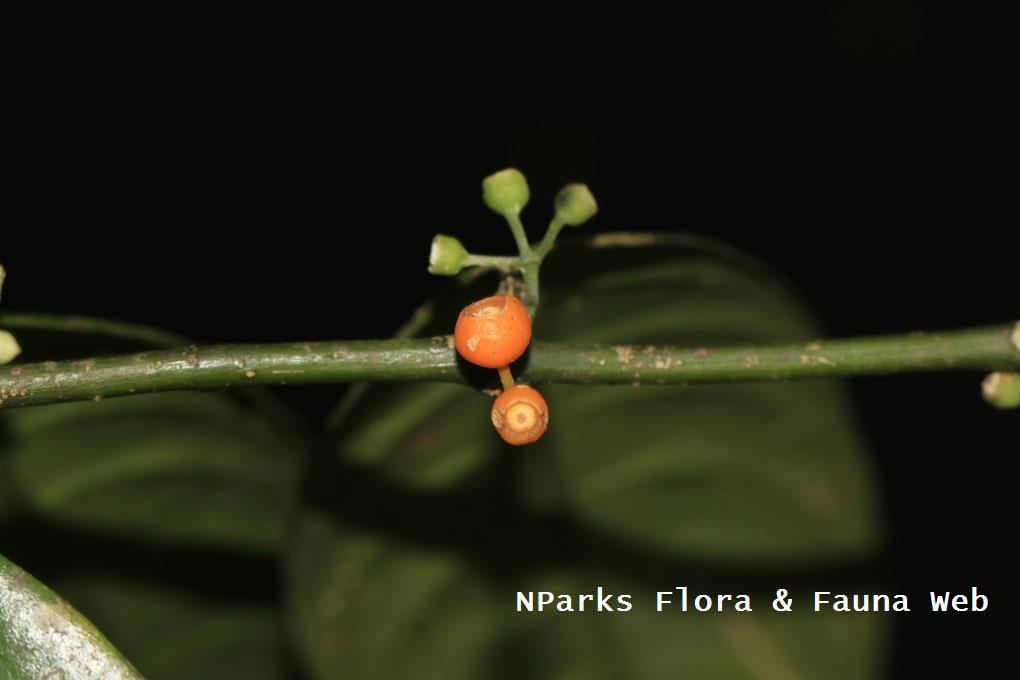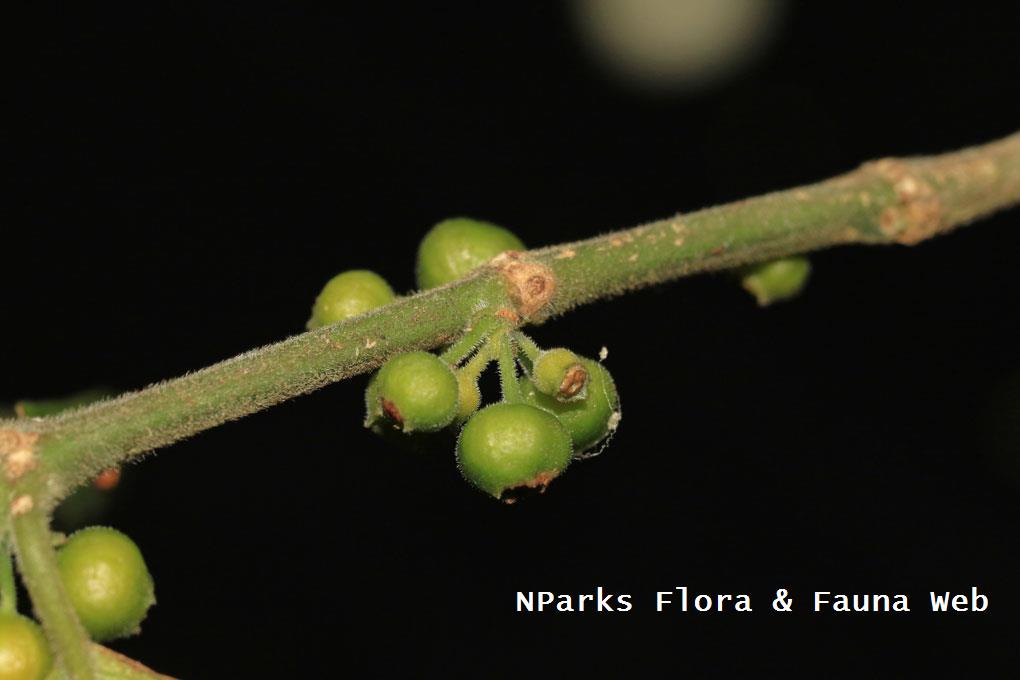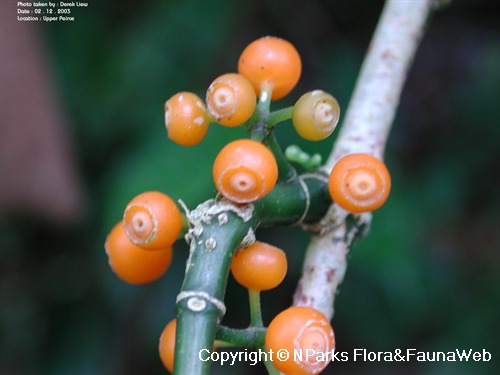
Back
Urophyllum arboreum (Reinw.) Korth.
| Family Name: | Rubiaceae |
| Synonyms: | Urophyllum macrophyllum auct. non (Blume) Korth. <1>, Urophyllum glabrum Wall. var. blumeanum (Wight) Ridl. |
| Common Name: | Melukut |
Urophyllum arboreum or Melukut is a treelet to small tree native to Singapore. Growing to 6.5 m tall, it has elliptic to oblanceolate leaves with almost parallel veinlets close together, perpendicular to the midrib. Flowers are dioecious, white, tubular, held in clusters of 2 - 3 at the tips. The fruit is an almost-round, berry with a broad ring scar at top. Upon maturity, it ripens from green to yellowish orange or red.
Name
Classifications and Characteristics
| Plant Division | Angiosperms (Flowering Seed Plants) (Dicotyledon) |
|---|---|
| Plant Growth Form | Tree (Small (6m-15m)) |
| Maximum Height | 6.5 m |
Biogeography
| Native Distribution | Peninsular Malaysia, Sumatra, Java, Borneo, Singapore |
|---|---|
| Native Habitat | Terrestrial (Freshwater Swamp Forest, Primary Rainforest) |
| Preferred Climate Zone | Tropical |
| Local Conservation Status | Native to Singapore (Vulnerable (VU)) |
Description and Ethnobotany
| Growth Form | It is a treelet to small tree that can grow to 6.5 m tall. |
|---|---|
| Foliage | Leaves are elliptic sometimes narrow spoon-shaped (oblanceolate) measuring 5.5 - 19.5 cm long by 1.7 - 6.5 cm wide. The midrib and lateral veins are prominent below, veinlets are close together, almost parallel to one another, somewhat perpendicular to the midrib. Stipules found at the nodes are linear to narrowly triangular, falls off in early stages. |
| Flowers | Flowers are dioecious, where the male and female flowers are produced on different individuals. They are tubular, held in clusters of 2 - 3 flowers at the tips, often with another cluster from a lower node on the main axis. Male flowers are dish-like, 1 - 1.5 mm long, 2 - 2.5 mm wide, 5 short triangular lobes less than 0.5 mm long. Female flowers has a cup-like base, 1.5 mm long, 2 - 2.5 mm wide with triangular lobes at 0.5 mm long. Both flowers may be smooth or have sparse, pale, brown flattened hairs on the outside. |
| Fruit | The fruit is almost-round berry which is 3 - 5 mm wide. It has a broad ring scar at the top, ripening from green to yellowish orange or red. |
| Habitat | Occurs commonly in lowland forest including swamp forest, lower montane forest and on limestone. |
| Cultivation | It can be propagated by seed. <2> |
| Etymology | The genus, Urophyllum Greek, uro meaning tail and phyllum meaning leaf in reference to the conspicuous tail-like prolongation of leaf apices. The species epithet, Latin, arboreus meaning tree-like; referring to the habit. |
Plant Care and Propagation
| Light Preference | Semi-Shade |
|---|---|
| Water Preference | Moderate Water |
| Plant Growth Rate | Moderate |
| Rootzone Tolerance | Fertile Loamy Soils, Well-Drained Soils |
| Propagation Method | Seed |
Foliar
| Foliar Type | Simple / Unifoliate |
|---|---|
| Foliar Arrangement Along Stem | Opposite |
| Foliar Attachment to Stem | Petiolate |
| Foliar Shape(s) | Non-Palm Foliage (Elliptical, Oblanceolate) |
| Foliar Venation | Reticulate |
| Foliar Margin | Entire |
| Foliar Apex - Tip | Acuminate, Acute, Obtuse |
| Foliar Base | Cuneate |
Non - Foliar and Storage
| Stem Type & Modification | Woody |
|---|
Floral (Angiosperm)
| Flower & Plant Sexuality | Unisexual Flowers , Dioecious |
| Flower Colour(s) | White |
|---|
| Flower Grouping | Cluster / Inflorescence |
| Flower Location | Terminal |
| Flower Symmetry | Radial |
| Flowering Habit | Polycarpic |
Fruit, Seed and Spore
| Mature Fruit Colour(s) | Orange, Red |
|---|---|
| Fruit Classification | Simple Fruit |
| Fruit Type | Fleshy Fruit , Berry |
References
| References | <1> Ridley, H.N. et. al (1923). The flora of Malay Peninsula, vol. 2(1), pp. 66. London: L. Reeve & Co., Ltd. <2> Wong, K.M. et. al. (2019). Urophyllum. Flora of Singapore, vol. 13, pp. 344-347. Singapore: Singapore Botanic Gardens, National Parks Board. |
|---|
Image Repository
Others
| Master ID | 34429 |
|---|---|
| Species ID | 8842 |
| Flora Disclaimer | The information in this website has been compiled from reliable sources, such as reference works on medicinal plants. It is not a substitute for medical advice or treatment and NParks does not purport to provide any medical advice. Readers should always consult his/her physician before using or consuming a plant for medicinal purposes. |





